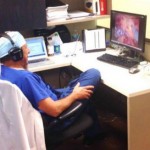Editorial: Robotic Networks – delivering empowerment through integration
Intuitive’s latest version of Connect™ for the Da Vinci Si model allows surgeons to communicate remotely via a laptop or personal computer, direct to the surgeon’s console. It has one-way video from the console to the remote mentor and bi-directional audio and telestration (drawing), replicating the successful strategy employed in many industries to develop networks, to share expertise and knowledge. The study published by Shin et al. [1] in this issue of BJUI is a technical proof of concept study and is an important first step to realising the potential of robotic networks. The study describes the application of Connect on a local area network (LAN), which is a network that interconnects computers in a limited geographical area such as a hospital, whereas a wide access network (WAN) is a computer network spanning regions, countries or even the world. The next logical advance for Connect is to study connections between different institutions, states and even internationally between countries. Connections between two UK NHS trusts have been successfully trialled, with plans for formal connections between hospitals in Sweden and the UK underway.
Minimally invasive surgery using video technologies has greatly improved opportunities for surgical learning. Telementoring has existed in various forms for >20 years and has been shown to have a positive impact on outcomes [2]. In a study by Påhlsson et al. [3], telementoring delivered by a high-volume surgeon at a tertiary hospital to a low-volume rural hospital, increased their cannulation rate in endoscopic retrograde cholangiopancreatography from 85% (one of the lowest in the country) to 99% (highest success rate).
While robotic surgery continues to evolve quickly, it remains an expensive service with required investment in surgeons’ learning curves in both established and new techniques. Maximum value is realised once the team is experienced, efficient and outcomes are optimised. Even between tertiary centres of excellence there are different skill sets. Successful collaborative approaches to training have potential to steepen learning curves. With Connect robotic trainers will have the additional option to disseminate their knowledge from a distance, without the need for mentor or mentee to travel.
Current healthcare WANs between hospitals can enable secure, quality assured connections over national and international networks. Connect will have a role in LANs [1]; however, studying telementoring across larger networks will probably define its beneficial effects on the learning curve. Connections between centres with the largest difference in skill sets are likely to show the greatest impacts.
Robotic networks are likely to exist in various forms and telementoring could be complemented by supplementary services delivered over both local and wide access networks. Future potential services over a LAN include real-time multi-disciplinary teams with direct communication from the console to the radiologists and histopathologists.
Simulators have been used in industries outside healthcare, such as the aviation industry, to measure both proficiency and technical skill learning. Although robotic surgical simulation has not yet reached a stage where it replicates all aspects of robotic surgical procedures, it currently has potential to accelerate trainees along their learning curve outside the operating room and thus contribute to patient safety. Simulators greatest future value may be aligned with the data and feedback that robotic networks will provide, replicating the roles of airport control centres and flight simulators. With better understanding of surgical learning curves and the ability to score and differentiate between performance levels [4], data collected via networks may also have a future role in regulation of surgery (Fig. 1).

Figure 1. Potential effect of robotic networks on identifying suboptimal technique and improving patient outcomes. (*Connect and Simulation diagrams by Intuitive Surgical™).
International robotic networks will help achieve balance between the continual cycle of optimisation and standardisation of robotic surgical techniques. Standardised live surgery broadcast from home institutions [5] could support and promote both telementoring and the benefits of standardised surgical techniques [5, 6]. Standardisation is critical to developing cohesive networks with better understanding between mentors and mentees. It also aids identification of the ‘hazard’ steps in complex multistep procedures, enabling strategies to avoid the associated complications [6].
Sharing of expertise requires shared goals. In highly competitive healthcare systems where hospitals compete in attracting patients, there is inherent resistance to sharing. Connect enables interaction between mentor and mentee and once hard endpoints are identified and the beneficial effects of sharing are studied, new thinking in robotic surgery is likely. If benefits to surgical outcomes and improved safety using Connect are confirmed, both legal and reimbursement issues will probably be resolved.
In conclusion, change is driven on varying scales from local discussion, to national and international opinion and debate. While Connect will undoubtedly enhance communication between surgeons, it is the development of WANs, connecting the centres with the biggest differences in skill sets, which may deliver the greatest improvements. Collaboration via robotic networks has the potential to not only enable but to drive advancement in multiple areas of robotic surgery through the sharing of knowledge, innovations and expertise, resulting in continuous incremental improvement.



